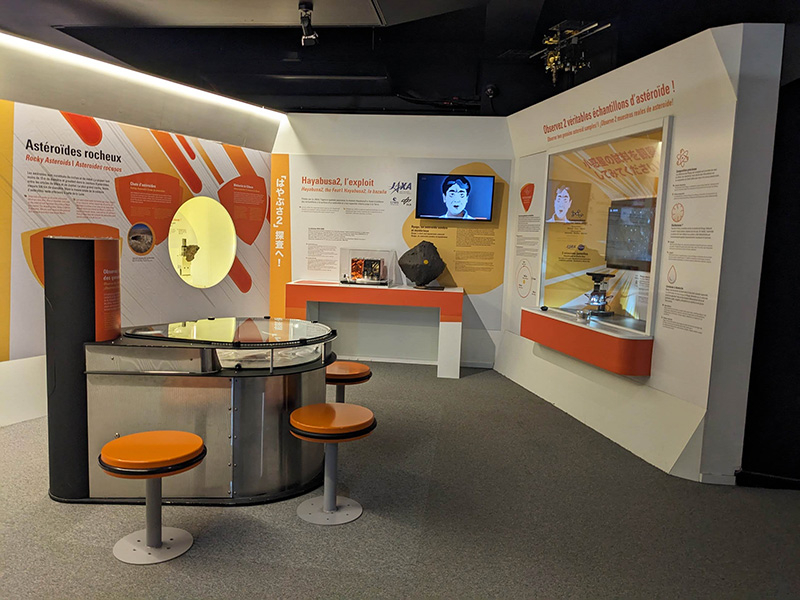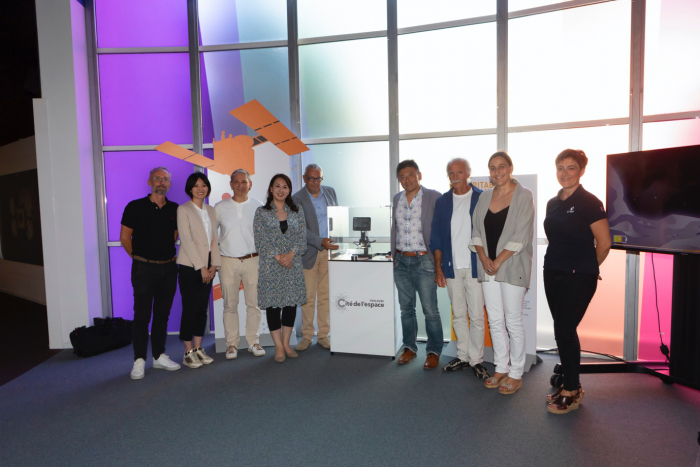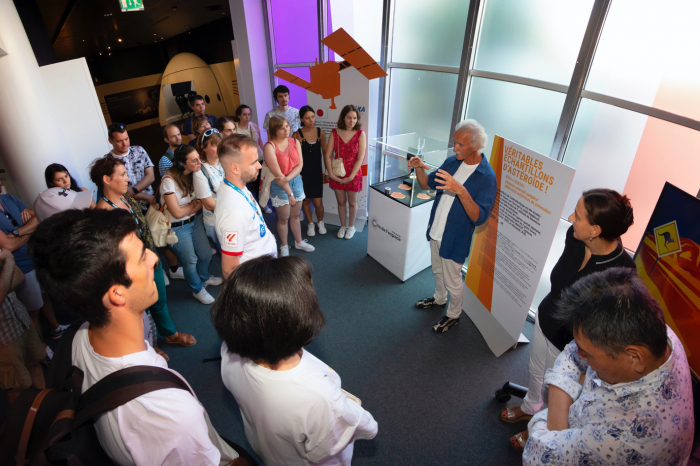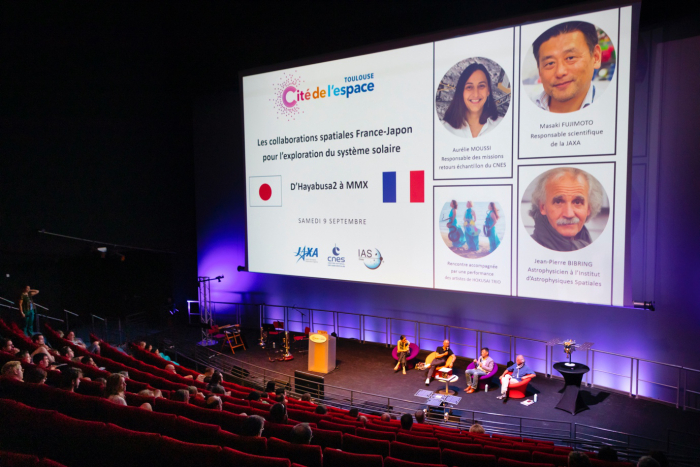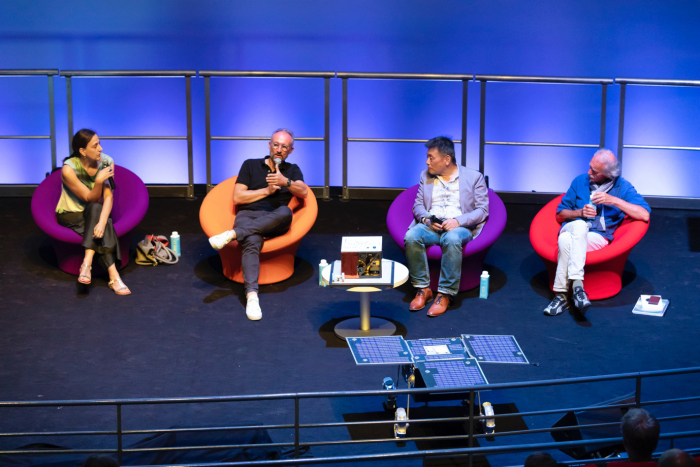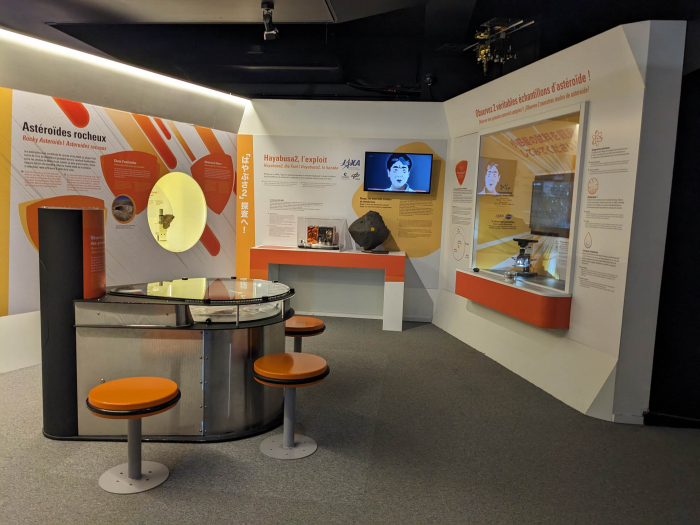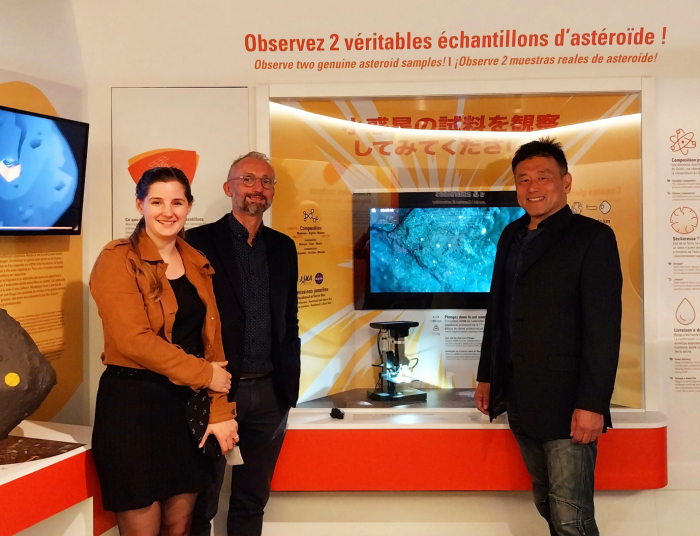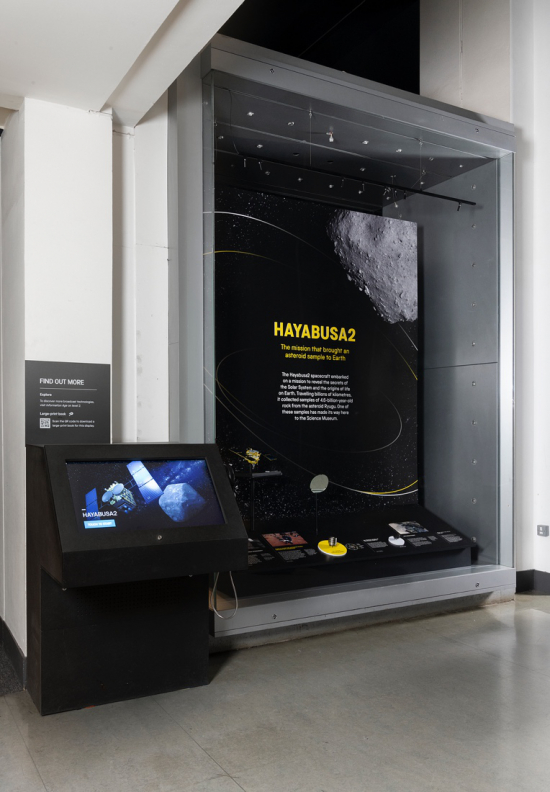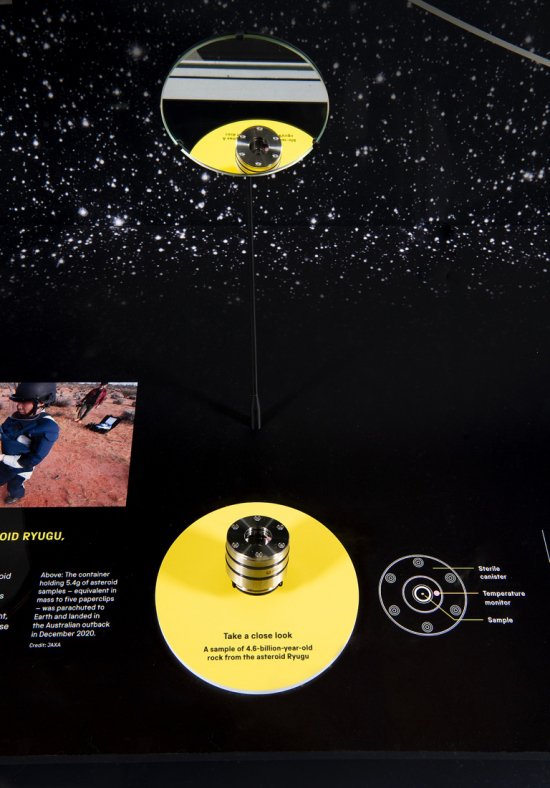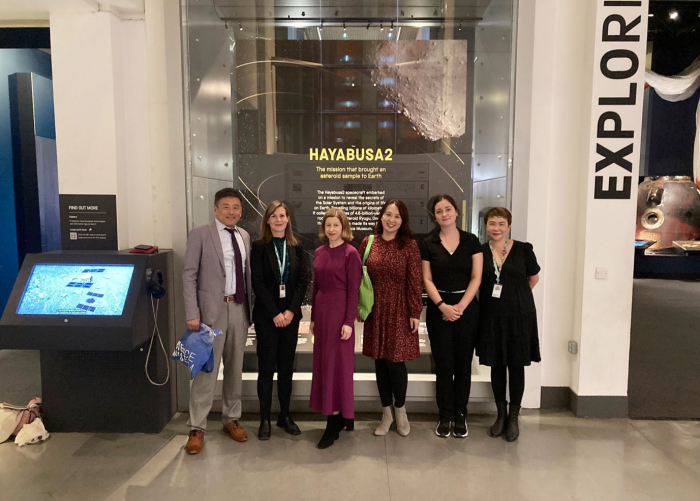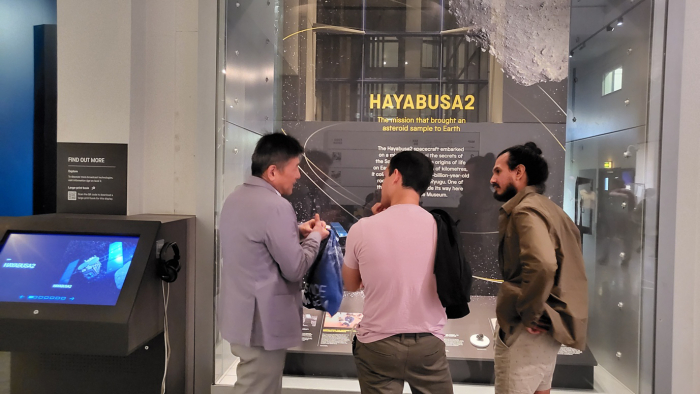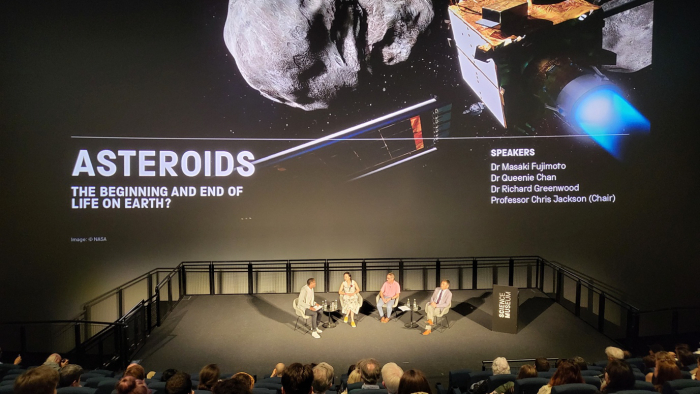This autumn, three grains from asteroid Ryugu that were returned by the Hayabusa2 mission went on public display in Europe. One grain can be seen at the Science Museum in London (UK), and two grains are being exhibited at Cité de l'espace in Toulouse (France).
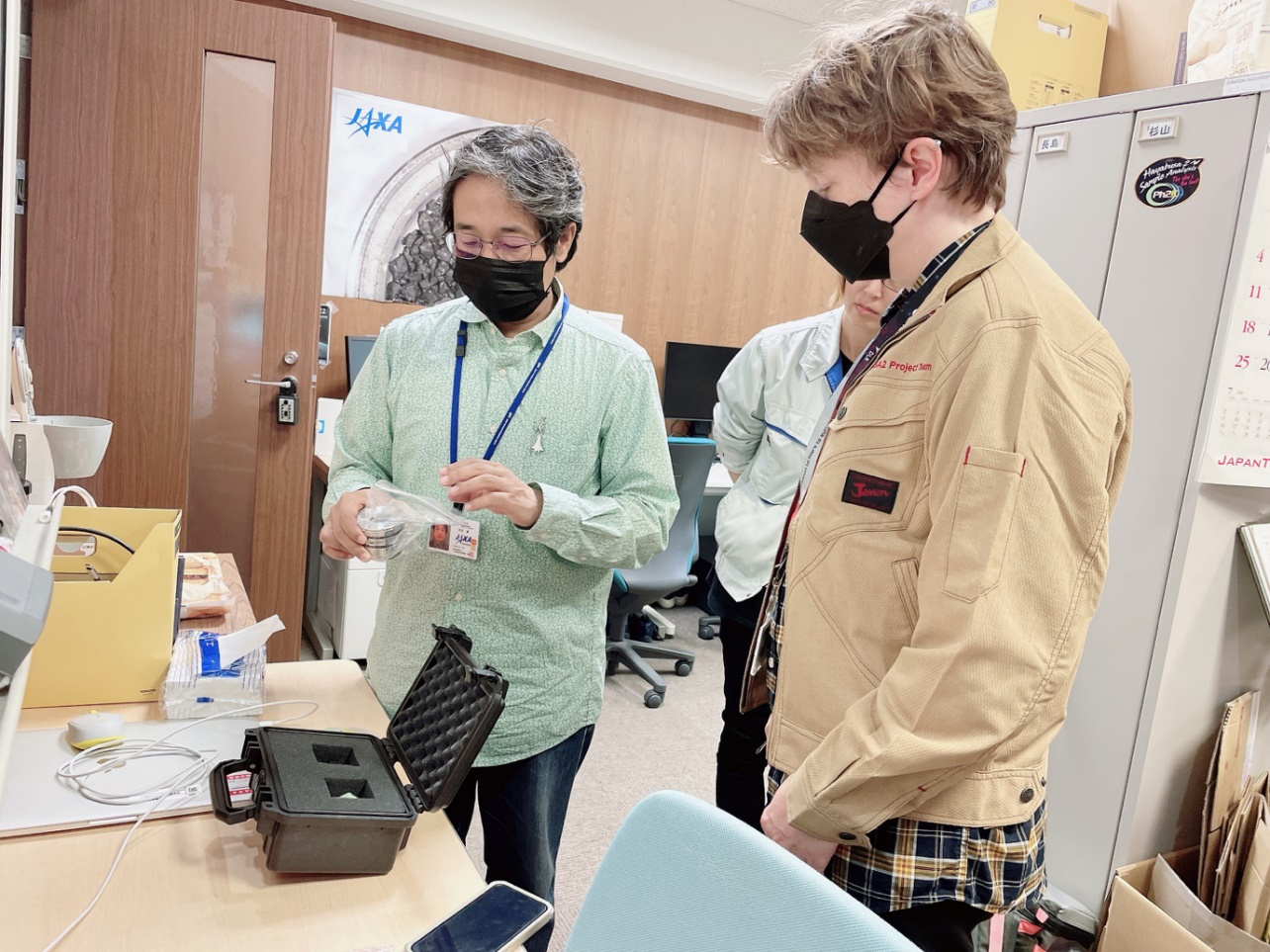
Associate Senior Researcher YADA Toru, who is leading the Hayabusa2 sample curation at ISAS, instructs Associate Professor Elizabeth TASKER on how to care for the delicate Ryugu sample grains during the journey from Japan to Europe.
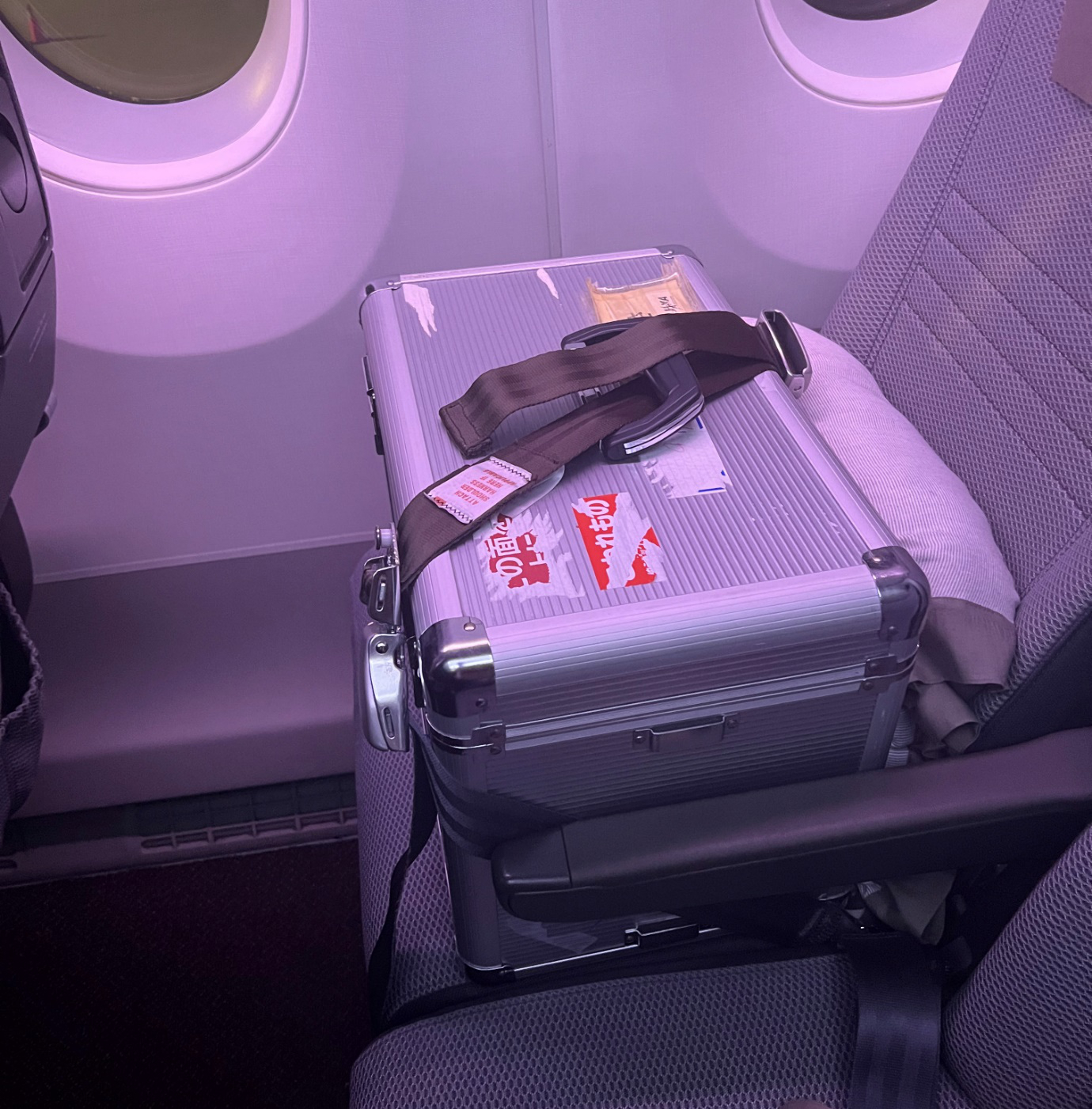
A 1:20 scale model of the Hayabusa2 spacecraft was also loaned to the Science Museum in London. The model is fragile, and has been carefully strapped into its aeroplane seat by cabin staff as it begins the trip to Europe from Japan!
Cité de l'espace initially opened a temporary exhibit space at the museum at the start of September to coincide with Japan playing in the Rugby World Cup in Toulouse. ISAS Deputy Director General Fujimoto Masaki and JAXA Space Education Director Kate Kitagawa visited Toulouse to meet rugby and space fans!
Members of the French and Japanese teams pose by the temporary exhibit space at the space museum. Despite not being the permeant exhibit display, it is beautifully put together with a clear view of the Ryugu grain on a screen attached to a microscope (credit: M. Huynh). From left to right, Christophe CHAFFARDON (Director of Education, Science and Culture, Cité de l'espace), HOSHINO Chiharu (JAXA), Sébastien BARDE (CNES), Kate KITAGAWA, Jean Baptiste DESBOIS (Chief Executive Officer, Cité de l'espace), FUJIMOTO Masaki, Jean-Pierre BIBRING (l'Institut d'Astrophysiques Spatiales), Aurélie MOUSSI (CNES) and Nathalie JOURNO (CNES) (credit: M. Huynh).
Bibring, Fujimoto, and Moussi talk the visitors through the exhibit (credit: M. Huynh).
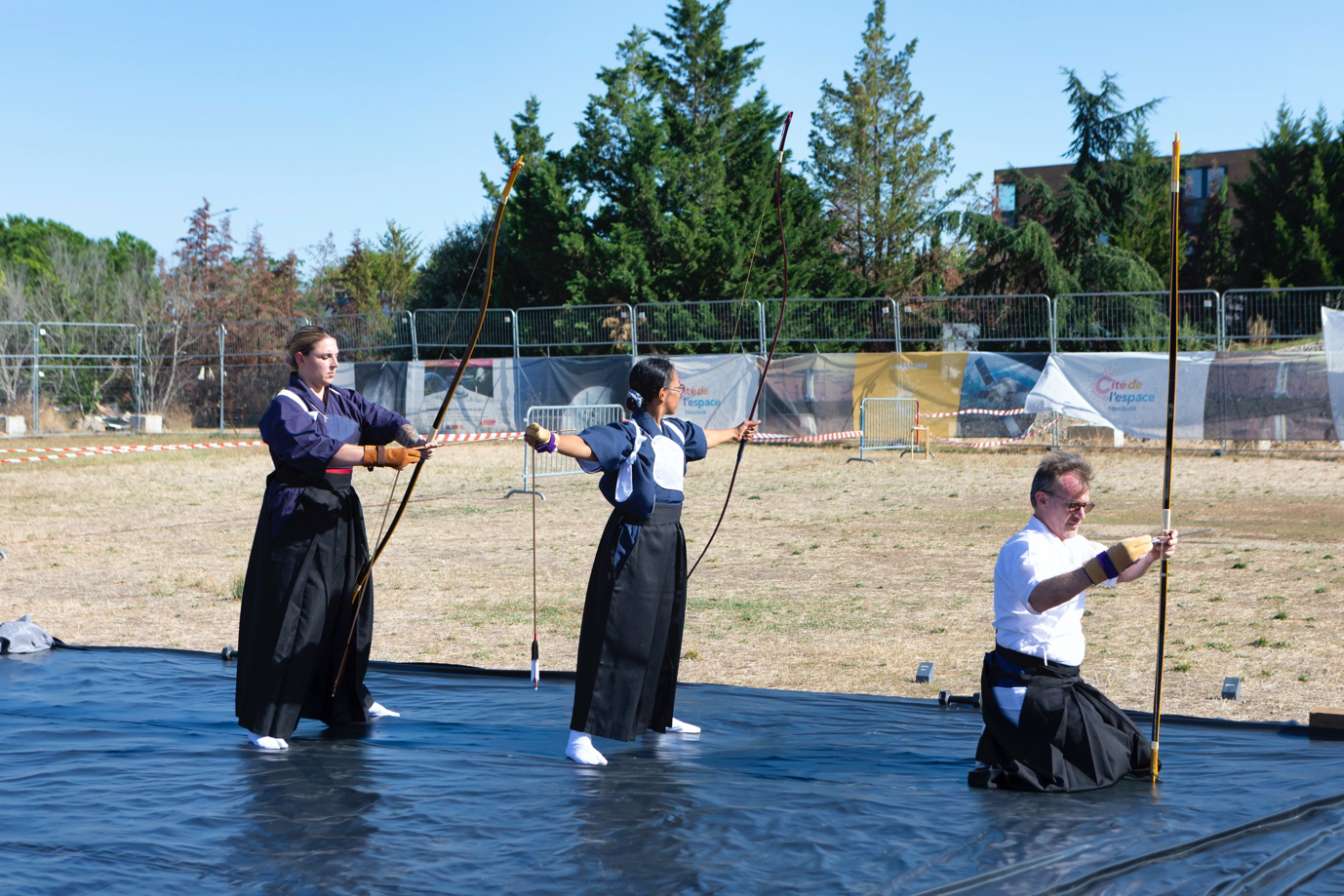
A display of Japanese archery (known as "Kyudo": 弓道) accompanied the exhibit opening (credit: M. Huynh).
In the evening, a round table discussion was held on asteroid and small body science with Bibring, Fujimoto, and Moussi who are sitting on the stage with Chaffardon. On the right of the stage is a model of the Hayabusa2 spacecraft, and in front of the speakers is a model of the rover developed by CNES and DLR to explore the Martian moon, Phobos, as part of the JAXA Martian Moons eXploration (MMX) mission (credit: M. Huynh).
The four speakers at the round table. Left to right: Moussi, Chaffardon, Fujimoto, and Bibring. The MMX rover is at the far front and behind it is MASCOT: the lander developed by CNES and DLR that investigated the surface of asteroid Ryugu as part of the Hayabusa2 mission (credit: M. Huynh).
In October, the display at Cité de l'espace was moved to a new permanent exhibition area, where it will be on display for about one year. This new space is much bigger, with a model of asteroid Ryugu and MASCOT (centre back) and the two Ryugu grains on the right, one under a microscope displayed to a big screen. The second grain can be viewed inside a Facility-to-Facility Transfer Container (FFTC): the same type used when transporting the grains for scientific study to laboratories around the world. An enlarged 3D printed model of one of the grains is also on the right, so its shape can be clearly seen. Above the display on the right, a 1:6 model of Hayabusa2 can be spotted (credit: Cité de l'espace).
ISAS Deputy Director General Fujimoto also visited the new exhibition space to see the Ryugu grains in their new home and how they will be displayed to the public! Fujimoto is on the right, seen here with Cité de l'espace Chaffardon and museographer Eglantine LELONG (credit: Cité de l'espace).
The exhibit at the Science Museum in London also opened in September. The team sent us photographs of the preparation to display the Ryugu grain inside the Facility-to-Facility Transfer Container, alongside a 1:20 scale model of the Hayabusa2 spacecraft that we had delivered from JAXA.
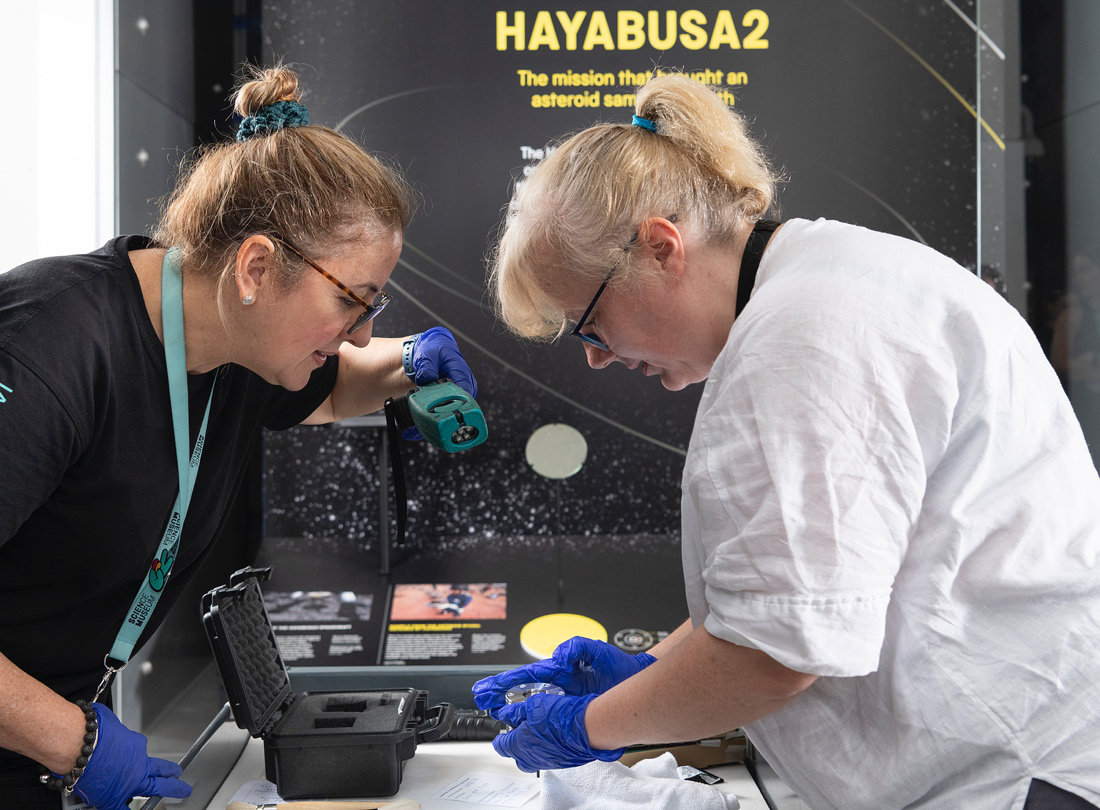
Science Museum Conservation Assistant Laura TONINO (left) and Conservator Kirsten STRACHAN carefully remove the FFTC containing the Ryugu grain from the travel case and prepare it for the display, which is taking shape in the background (credit: Science Museum Group).
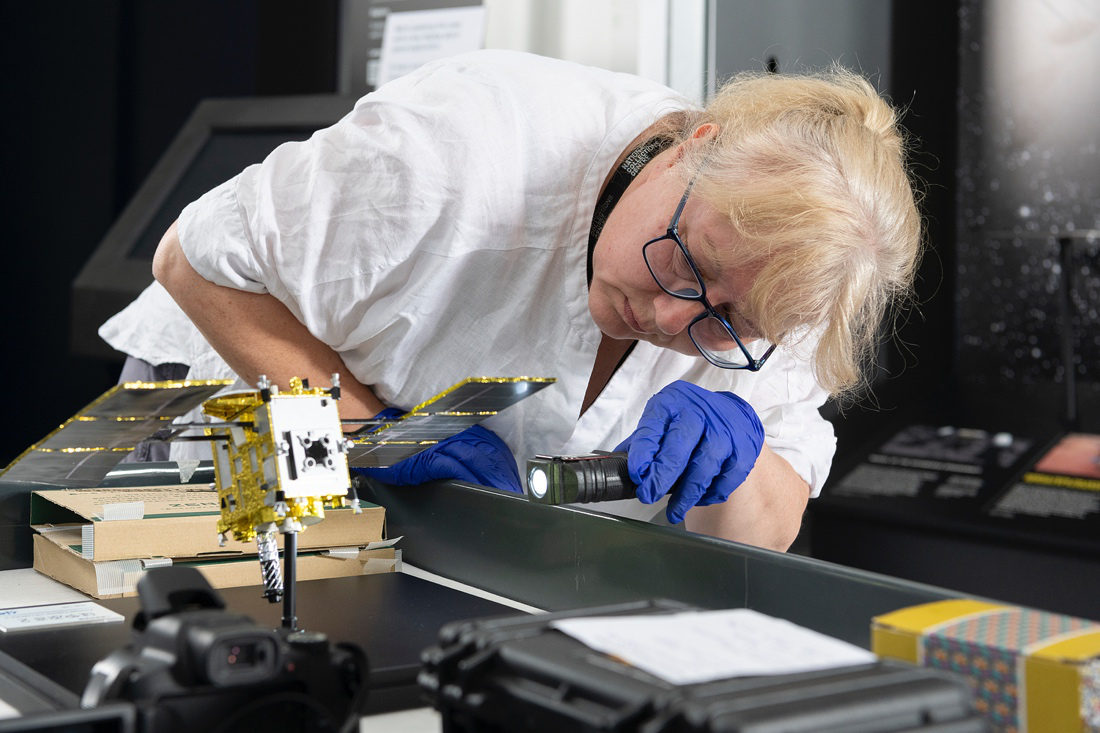
Strachan carefully examines the delicate Hayabusa2 model to ensure it is mounted perfectly, and no harm will come to it while it is in the exhibit (credit: Science Museum Group).
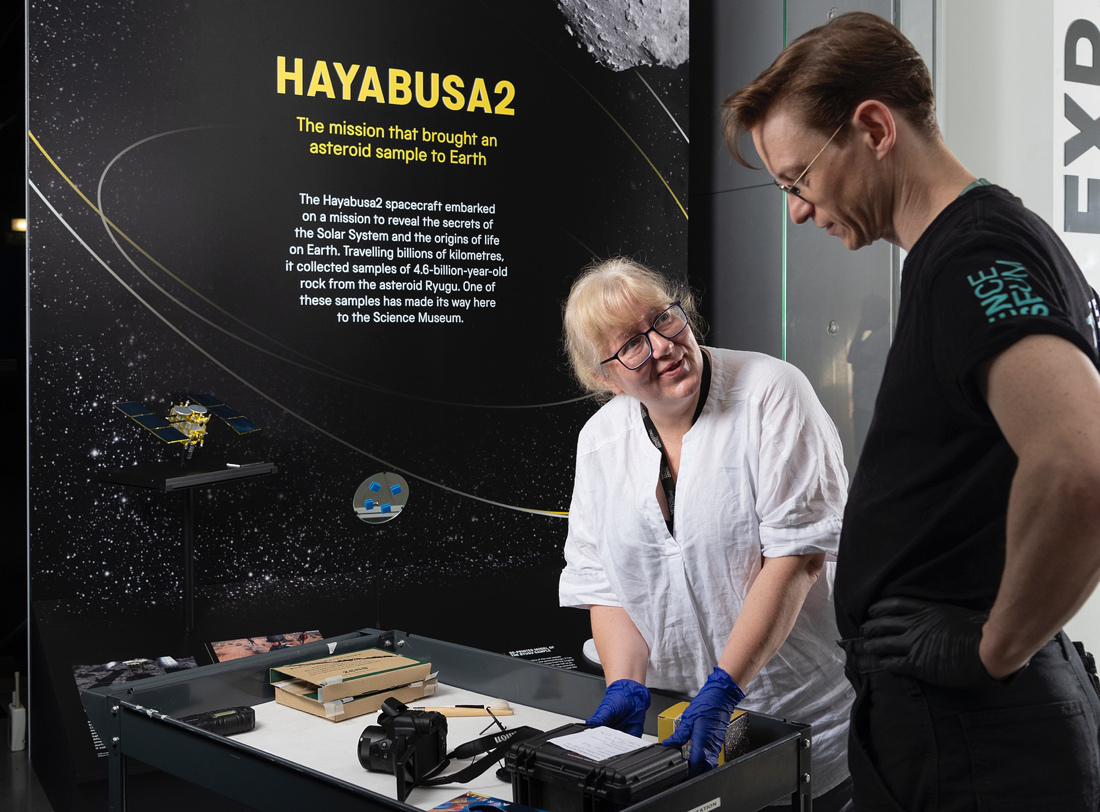
Strachan and Production Technician Nick BLYTHE discuss progress as the exhibit is meticulously assembled (credit: Science Museum Group).
The finished exhibit at the Science Museum! On the left, a video describing the Hayabusa2 mission can be played by visitors, featuring interviews with Deputy Director Fujimoto Masaki, Hayabusa2 Project Manager TSUDA Yuichi, and Hayabusa2 Mission Manager YOSHIKAWA Makoto. The Ryugu grain in the FFTC sits in the yellow circle with a mirror to reflect a clear view of the container. The Hayabusa2 model is mounted on the left inside the display case, and an enlarged 3D printed model of the grain is on the right (credit: Science Museum Group).
A close up of the Ryugu grain inside the FFTC, with its reflection in the mirror above (credit: Science Museum Group).
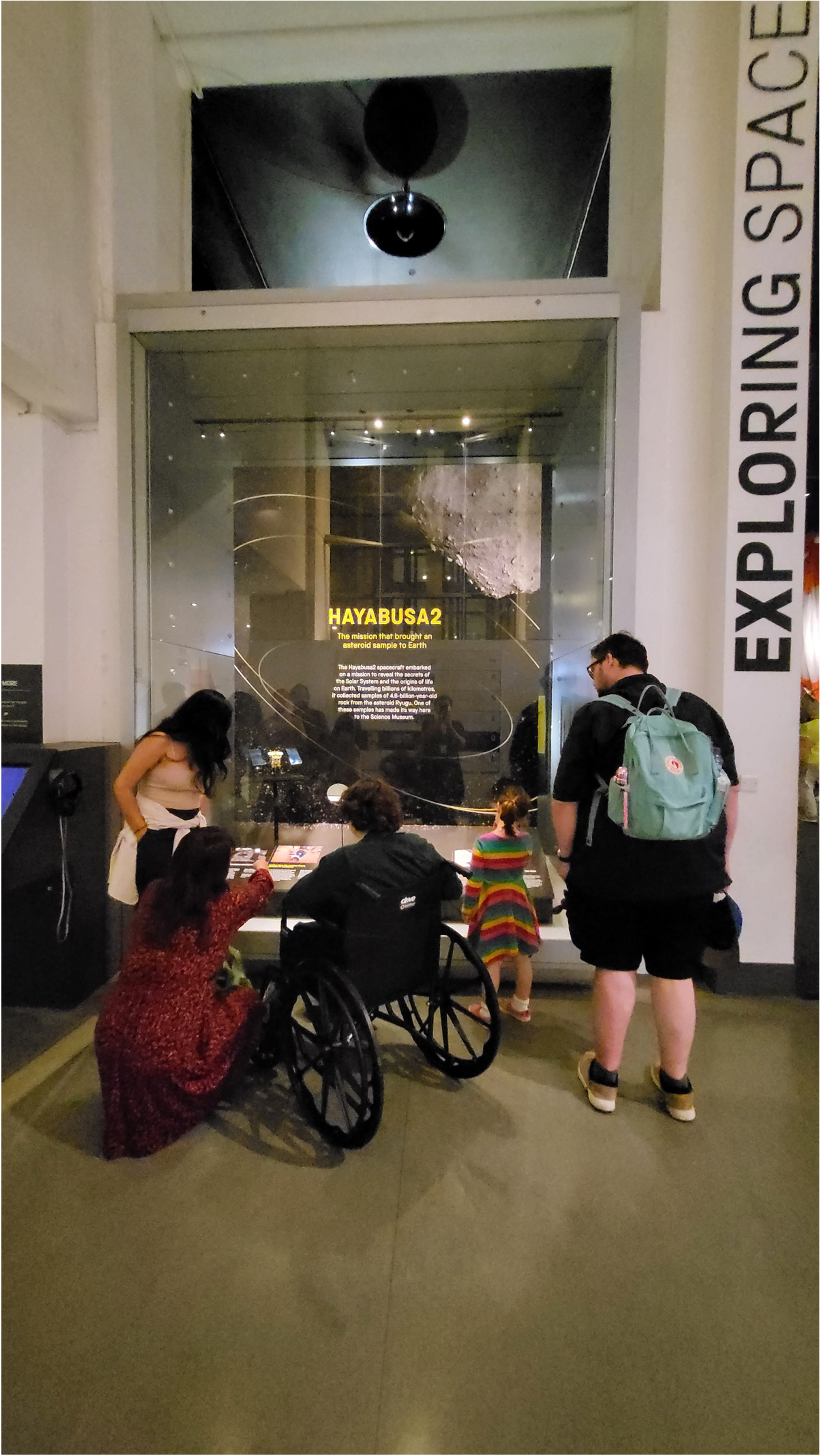
Accessibility is of key importance at the Science Museum, and the Ryugu grain was displayed so that it can be viewed by people examining the exhibit from different heights (credit: Science Museum Group).
The London Science Museum team with JAXA members Fujimoto and Kitagawa! From left to right: Fujimoto, Jessica BRADFORD (Head of Collections & Principal Curator at the Science Museum), Julia KNIGHTS (Deputy Director of the Science Museum), Kitagawa, Heather BENNETT (Museum Curator of Space Technology) and Cherie HUANG (International Engagement Manager, Science Museum).
ISAS Deputy Director Fujimoto Masaki was recognised from the video when he visited the newly opened exhibition in London, and gave an impromptu tour of the exhibit! (credit: Science Museum Group.)
To mark the opening of the Science Museum Exhibit, the museum held a "Stargazing Lates" evening event, where visitors could come to the museum after hours to hear talks and discussions. Fujimoto joined a panel on asteroids with Queenie CHAN (senior lecturer in Earth Sciences, Royal Holloway University of London), Richard GREENWOOD (Senior Research Fellow in Planetary Sciences at the Open University), and Chris JACKSON (Geoscientist, science communicator and Director of Sustainable Geoscience at Jacobs Engineering Group).
The two exhibits in Toulouse and London are beautiful displays, with a plethora of information about the Hayabusa2 mission and asteroids. We are grateful to the wonderful teams at Cité de l'espace and the Science Museum for their enthusiasm and care in constructing these incredible unique experiences. The asteroid Ryugu grains will be on display at both locations through much of 2024, so please visit if you can!
Links
- Cité de l'espace exhibit
- The Science Museum exhibit
- Delivering asteroid Ryugu grains to Cité de l'espace
- How to carry an asteroid around the world (Cosmos blog)
- The first international exhibits of grains from asteroid Ryugu begin!
(2023/11/10)

